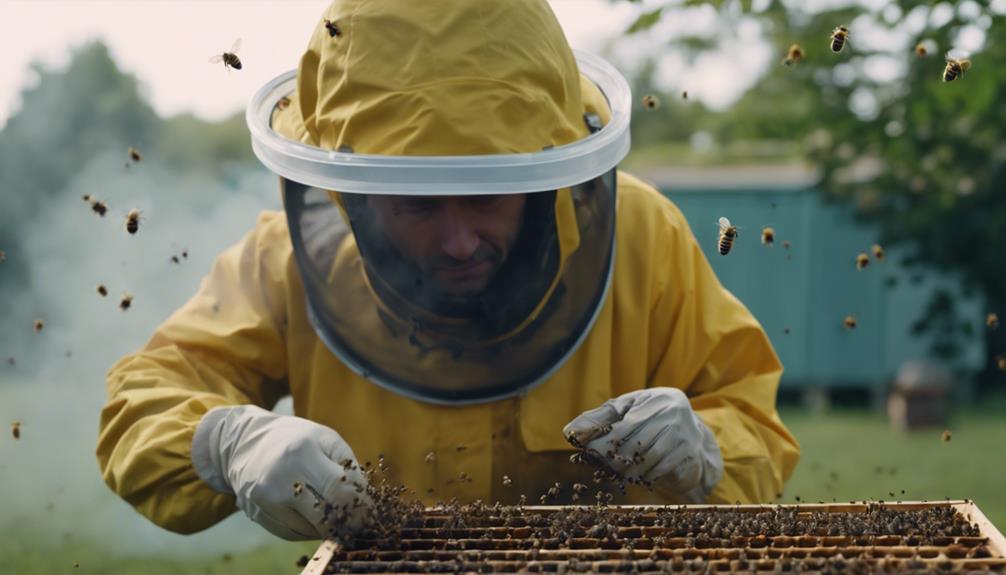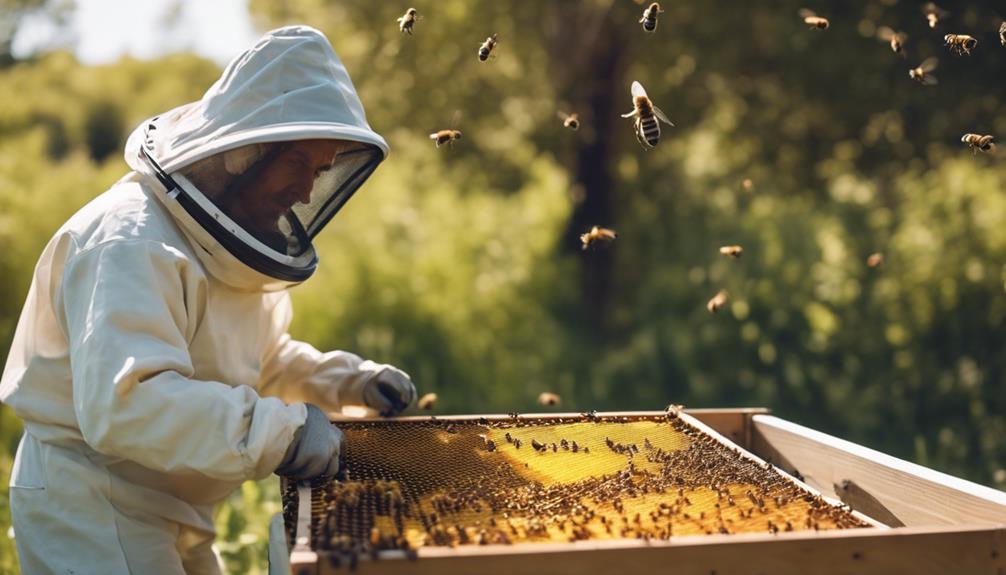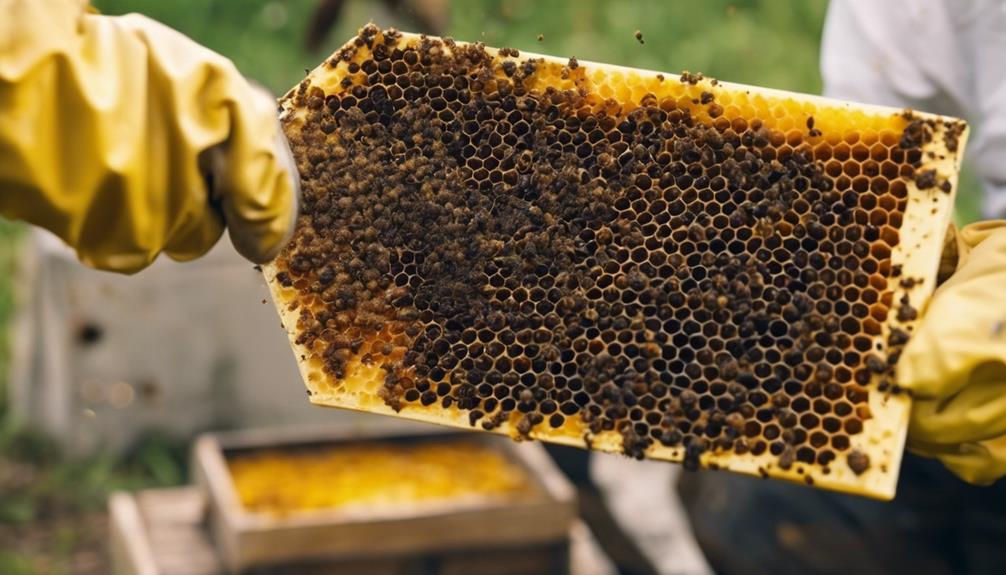Bee handlers can get stung since bees sting defensively when threatened or provoked. Quick movements near hives can trigger these defensive responses, but bees tend to sting less when away from their hive. To prevent stings, staying calm and wearing important protective gear like veils, suits, and gloves is vital in beekeeping practices. Understanding bee behavior and using gentle techniques, such as slow movements and proper smoke usage, can also help minimize stings. So, if you want to learn more about handling bees safely and reducing the chances of getting stung, keep exploring tips and strategies for successful beekeeping.
Main Points
- Bee handlers can get stung if bees feel threatened.
- Quick movements near hives trigger defensive stings.
- Proper gear like suits and veils can prevent stings.
- Handling bees gently reduces the risk of stings.
- Strategic hive placement minimizes bee encounters.
Understanding Bee Behavior for Safety
When handling bees, understanding their behavior is essential for ensuring safety and preventing stings. Bees sting not out of aggression but when they feel threatened or provoked. By observing bee behavior, bee handlers can predict and prevent defensive reactions that may lead to stings.
Quick movements or disturbances near a hive can trigger defensive responses in bees, increasing the likelihood of stings. Surprisingly, bees are less likely to sting when they’re away from their hive or colony, making it vital for bee handlers to be aware of their surroundings.
To minimize stings, bee handlers should stay calm, closely monitor bee behavior, and utilize proper protective gear. By understanding bee behavior, bee handlers can create a safer environment for themselves and the bees.
Importance of Proper Protective Gear
Proper protective gear plays an important role in safeguarding bee handlers from stings and ensuring their safety during hive inspections. When beekeepers suit up with the right equipment, they can reduce the risk of getting stung and work more confidently around their buzzing friends. Here are some key reasons why protective gear is vital:
- Veils and Suits: These items provide a physical barrier between bee handlers and the bees, minimizing the chances of stings.
- Gloves: Protective gloves offer an extra layer of defense, especially when handling the frames inside hives.
- Full Coverage: Suits that cover the entire body are essential to protect against unexpected bee encounters.
- Preventive Measure: Wearing the proper gear is a proactive step in beekeeping safety, ensuring a more pleasant bee-handling experience.
Techniques to Minimize Bee Stings

So, how can we keep those bee stings at bay?
Well, one way is to make sure we’re equipped with the right protective clothing.
Handling bees gently is another key technique to minimize those stings.
Protective Clothing Tips
To minimize bee stings while handling bees, beekeepers should prioritize wearing properly fitted protective clothing, including veils, gloves, and full suits. Ensuring that all exposed skin is covered is key to preventing painful encounters with bees. Here are some tips to help you stay sting-free:
- Choose veils with tight weaves for maximum protection.
- Opt for full coverage gloves to shield your hands from stings.
- Wear full suits that fit well and are securely fastened.
- Invest in high-quality protective clothing to create a reliable barrier between you and the bees.
Handling Bees Gently
When handling bees, employing gentle techniques can significantly reduce the risk of bee stings. Experienced beekeepers know that slow movements and avoiding sudden gestures can help decrease bee aggression. Reading bee behavior during hive inspections is essential to prevent stings.
Proper use of smoke can calm bees, making handling them easier and reducing the likelihood of stings. Wearing the right protective gear, such as veils and gloves, is vital for beekeepers to stay safe while working with bees.
Strategic Hive Placement Tips
Strategically placing beehives in secluded areas with minimal human activity can significantly reduce the risk of bee stings. When considering where to put your hives, keep these tips in mind:
- Choose Quiet Locations: Select spots away from high human traffic to keep bees calm.
- Provide Natural Barriers: Opt for areas with vegetation or barriers for bee security.
- Consider Environmental Factors: Guarantee hives have sunlight, wind protection, and water nearby.
- Promote Harmony: Proper hive placement fosters a better relationship between beekeepers and bees, leading to fewer stings.
Maintaining Calmness During Bee Handling

When handling bees, it’s essential to maintain a sense of calmness. Our breathing techniques can help us stay relaxed and focused.
Breathing Techniques for Calmness
To maintain a sense of calmness during bee handling, beekeepers can practice deep breathing techniques. Controlled breathing not only helps reduce anxiety but also improves focus and composure, creating a safer environment for both the bees and the handlers. Here are some simple yet effective breathing exercises to stay calm around bees:
- Take slow, deep breaths in through your nose and out through your mouth.
- Focus on the sensation of your breath entering and leaving your body.
- Pause between each breath to center yourself and maintain a steady rhythm.
- Use breathing techniques to avoid sudden movements that may agitate the bees.
Gentle Movements Prevent Agitation
Gentle movements play a crucial role in preventing agitation and promoting calmness during bee handling. When handling bees, sudden gestures can trigger defensive reactions, increasing the risk of stings. By moving slowly and gracefully, we create a peaceful environment, reducing the chances of agitation.
Maintaining a calm demeanor around bees is essential; they can sense our energy. So, let’s approach them with tranquility and respect. Patience is our ally in handling bees – swift actions may lead to unwanted encounters with their stingers.
Confidence Boosts Handling Success
Our confidence in handling bees calmly significantly impacts our success in minimizing stings and fostering a harmonious interaction with these fascinating creatures. Experienced bee handlers exude confidence and maintain calmness around bees, which helps minimize the likelihood of stings. To boost handling success, consider these tips:
- Approach the bees with a relaxed demeanor.
- Use slow and deliberate movements during hive inspections.
- Maintain a positive attitude towards the bees.
- Trust in your bee handling skills and stay composed even in challenging situations.
Addressing Bee Sting Situations

Experienced bee handlers understand the importance of promptly addressing bee sting situations to prevent complications and safeguard their own safety.
When a beekeeper gets stung, the bee’s stinger injects venom into the skin, causing pain, swelling, and redness. While most beekeepers develop a tolerance to bee stings over time, some may experience allergic reactions that require immediate medical attention.
It’s vital for beekeepers to wear protective gear like veils and gloves to minimize the risk of being stung. If stung, it’s recommended to remove the stinger promptly to reduce the amount of venom entering the body.
Properly managing bee stings not only guarantees a smoother handling experience but also promotes a safer environment for both beekeepers and bees.
Promoting Coexistence With Bees
To foster harmonious coexistence with bees, bee handlers must prioritize understanding and respecting the intricate dynamics of bee colonies. In terms of beekeeping and staying safe from stings, there are a few key practices we can follow:
- Study Bee Behavior: Observing how bees interact within the colony can help us anticipate their reactions and avoid being stung.
- Wear Protective Gear: Utilizing proper protective clothing, such as bee suits and gloves, is essential to minimize the risk of stings.
- Learn from Experienced Beekeepers: Seasoned beekeepers have valuable insights on how to work with bees effectively and avoid being stung.
- Develop Techniques: Over time, bee handlers can develop strategies to stay safe and promote a peaceful coexistence with bees.

Roger Thomas is a seasoned beekeeper and hive architect with a deep-seated passion for sustainable living. His fascination with bees has shaped his professional career, giving him practical and theoretical expertise in bee behavior, colony health, and optimal hive conditions. Roger’s technical skills shine in his bespoke hive creations that cater to the specific needs of diverse bee species, while his sustainable practices promote environmental balance and the wellbeing of the bee population.
As he continues his journey in beekeeping, Roger has become a dedicated advocate for responsible practices and an insightful educator in his field. His posts aim to inspire new beekeepers, underline the importance of sustainability, and showcase the remarkable contribution bees make to our ecosystem. Roger invites you to join him as he delves into the world of bees and the rewarding, honey-sweet art of beekeeping.


